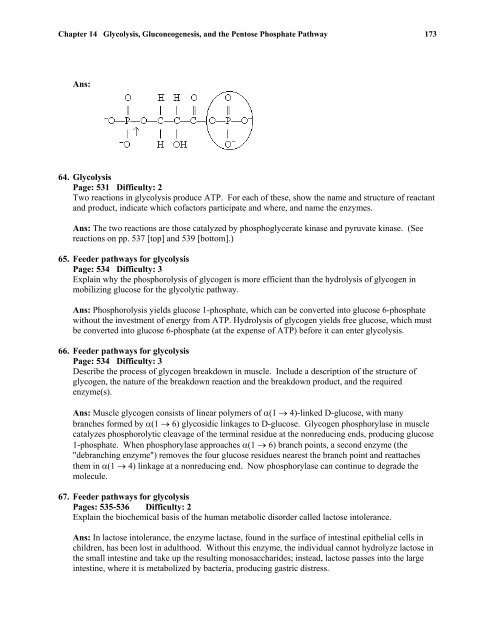Chapter 14 Glycolysis, Gluconeogenesis, and the Pentose
Chapter 14 Glycolysis, Gluconeogenesis, and the Pentose
Chapter 14 Glycolysis, Gluconeogenesis, and the Pentose
You also want an ePaper? Increase the reach of your titles
YUMPU automatically turns print PDFs into web optimized ePapers that Google loves.
<strong>Chapter</strong> <strong>14</strong> <strong>Glycolysis</strong>, <strong>Gluconeogenesis</strong>, <strong>and</strong> <strong>the</strong> <strong>Pentose</strong> Phosphate Pathway 173Ans:64. <strong>Glycolysis</strong>Page: 531 Difficulty: 2Two reactions in glycolysis produce ATP. For each of <strong>the</strong>se, show <strong>the</strong> name <strong>and</strong> structure of reactant<strong>and</strong> product, indicate which cofactors participate <strong>and</strong> where, <strong>and</strong> name <strong>the</strong> enzymes.Ans: The two reactions are those catalyzed by phosphoglycerate kinase <strong>and</strong> pyruvate kinase. (Seereactions on pp. 537 [top] <strong>and</strong> 539 [bottom].)65. Feeder pathways for glycolysisPage: 534 Difficulty: 3Explain why <strong>the</strong> phosphorolysis of glycogen is more efficient than <strong>the</strong> hydrolysis of glycogen inmobilizing glucose for <strong>the</strong> glycolytic pathway.Ans: Phosphorolysis yields glucose 1-phosphate, which can be converted into glucose 6-phosphatewithout <strong>the</strong> investment of energy from ATP. Hydrolysis of glycogen yields free glucose, which mustbe converted into glucose 6-phosphate (at <strong>the</strong> expense of ATP) before it can enter glycolysis.66. Feeder pathways for glycolysisPage: 534 Difficulty: 3Describe <strong>the</strong> process of glycogen breakdown in muscle. Include a description of <strong>the</strong> structure ofglycogen, <strong>the</strong> nature of <strong>the</strong> breakdown reaction <strong>and</strong> <strong>the</strong> breakdown product, <strong>and</strong> <strong>the</strong> requiredenzyme(s).Ans: Muscle glycogen consists of linear polymers of α(1 → 4)-linked D-glucose, with manybranches formed by α(1 → 6) glycosidic linkages to D-glucose. Glycogen phosphorylase in musclecatalyzes phosphorolytic cleavage of <strong>the</strong> terminal residue at <strong>the</strong> nonreducing ends, producing glucose1-phosphate. When phosphorylase approaches α(1 → 6) branch points, a second enzyme (<strong>the</strong>"debranching enzyme") removes <strong>the</strong> four glucose residues nearest <strong>the</strong> branch point <strong>and</strong> reattaches<strong>the</strong>m in α(1 → 4) linkage at a nonreducing end. Now phosphorylase can continue to degrade <strong>the</strong>molecule.67. Feeder pathways for glycolysisPages: 535-536 Difficulty: 2Explain <strong>the</strong> biochemical basis of <strong>the</strong> human metabolic disorder called lactose intolerance.Ans: In lactose intolerance, <strong>the</strong> enzyme lactase, found in <strong>the</strong> surface of intestinal epi<strong>the</strong>lial cells inchildren, has been lost in adulthood. Without this enzyme, <strong>the</strong> individual cannot hydrolyze lactose in<strong>the</strong> small intestine <strong>and</strong> take up <strong>the</strong> resulting monosaccharides; instead, lactose passes into <strong>the</strong> largeintestine, where it is metabolized by bacteria, producing gastric distress.




